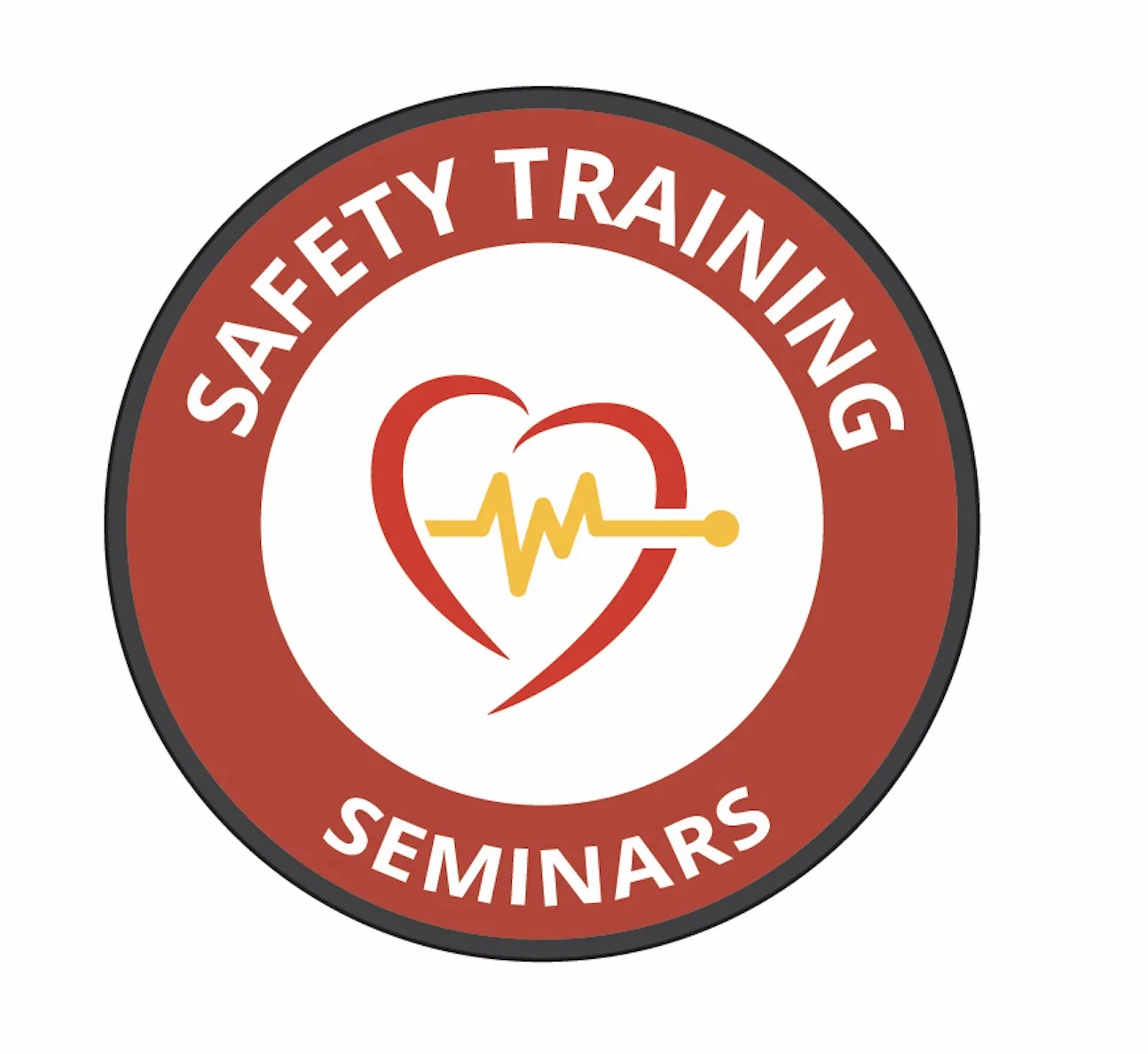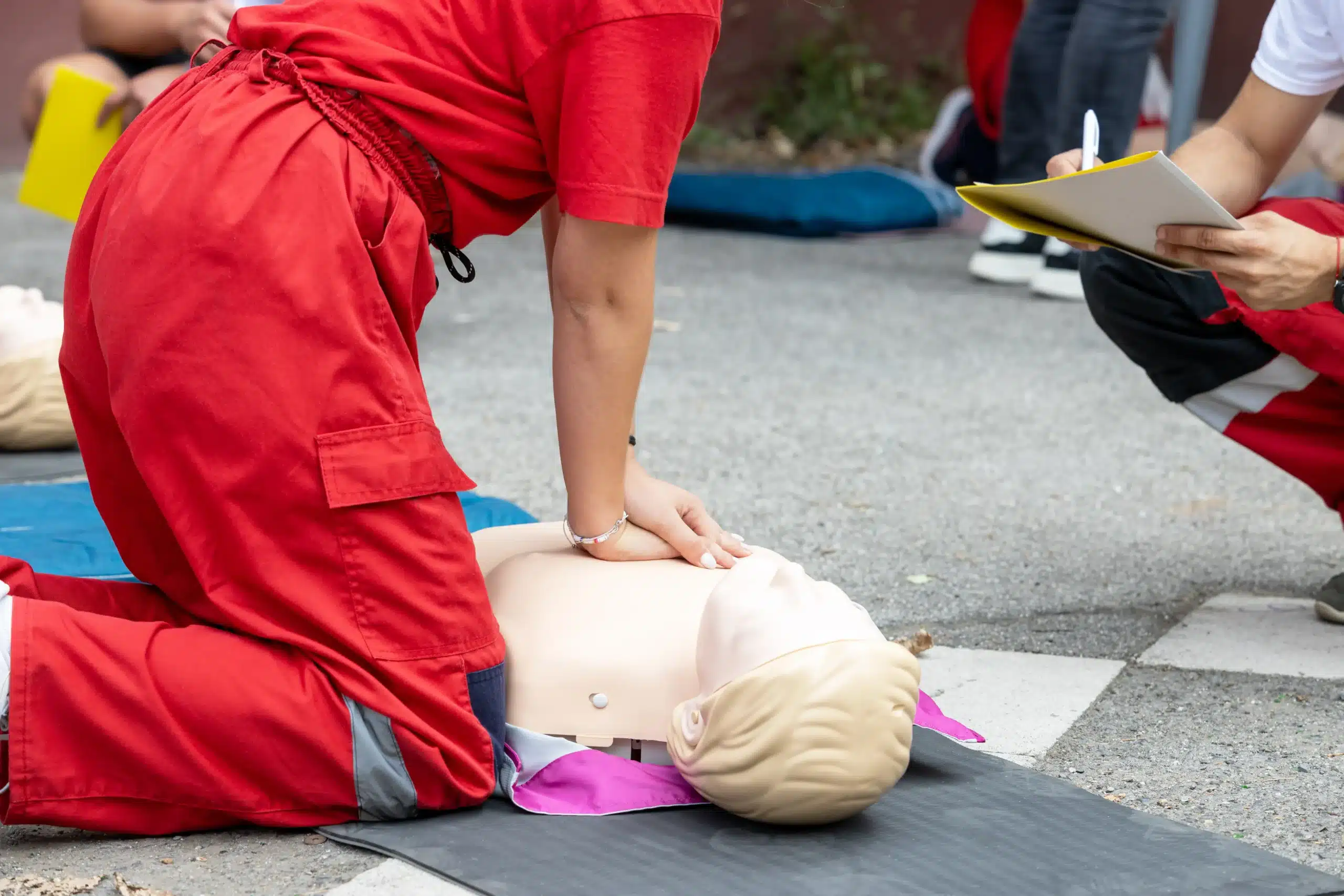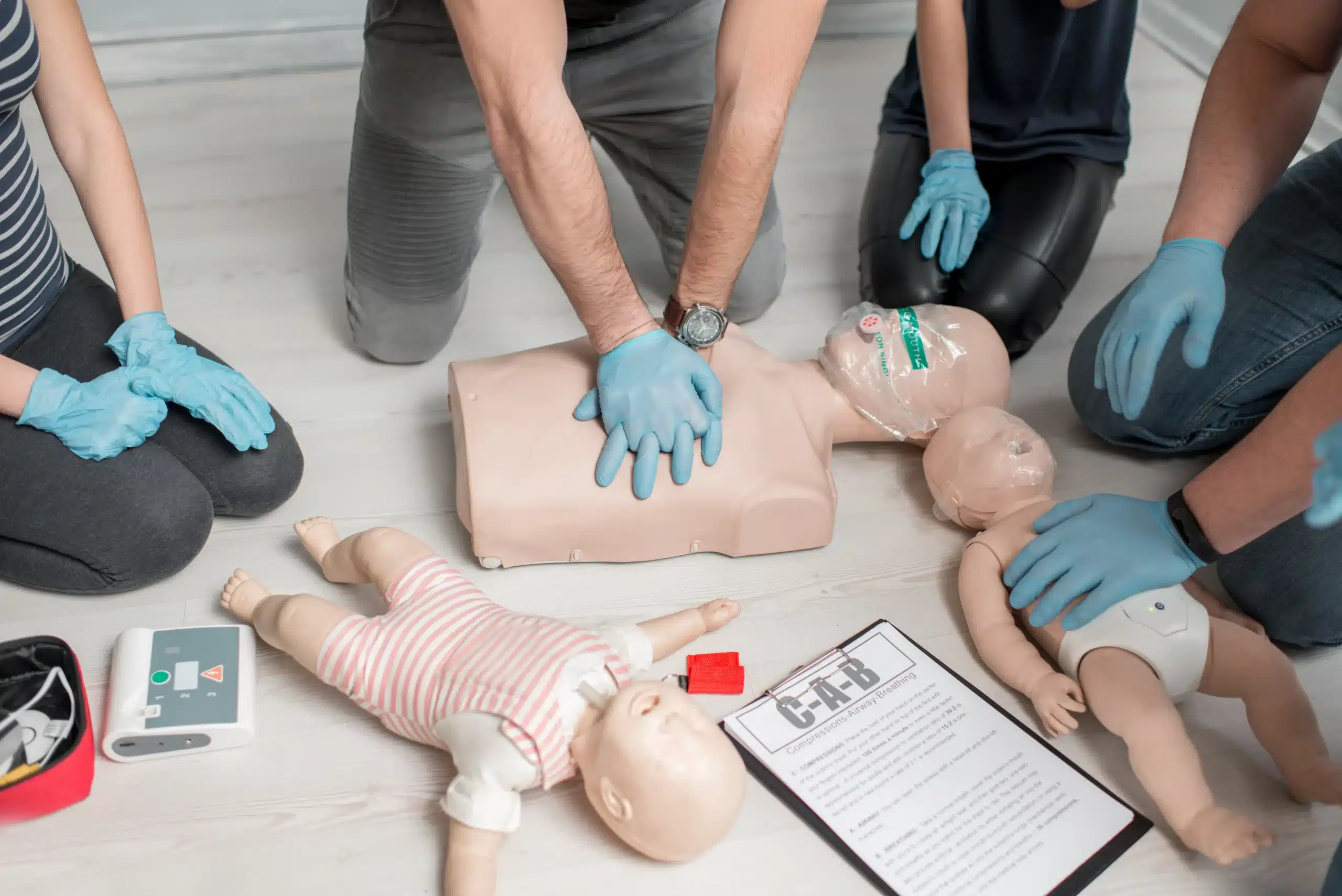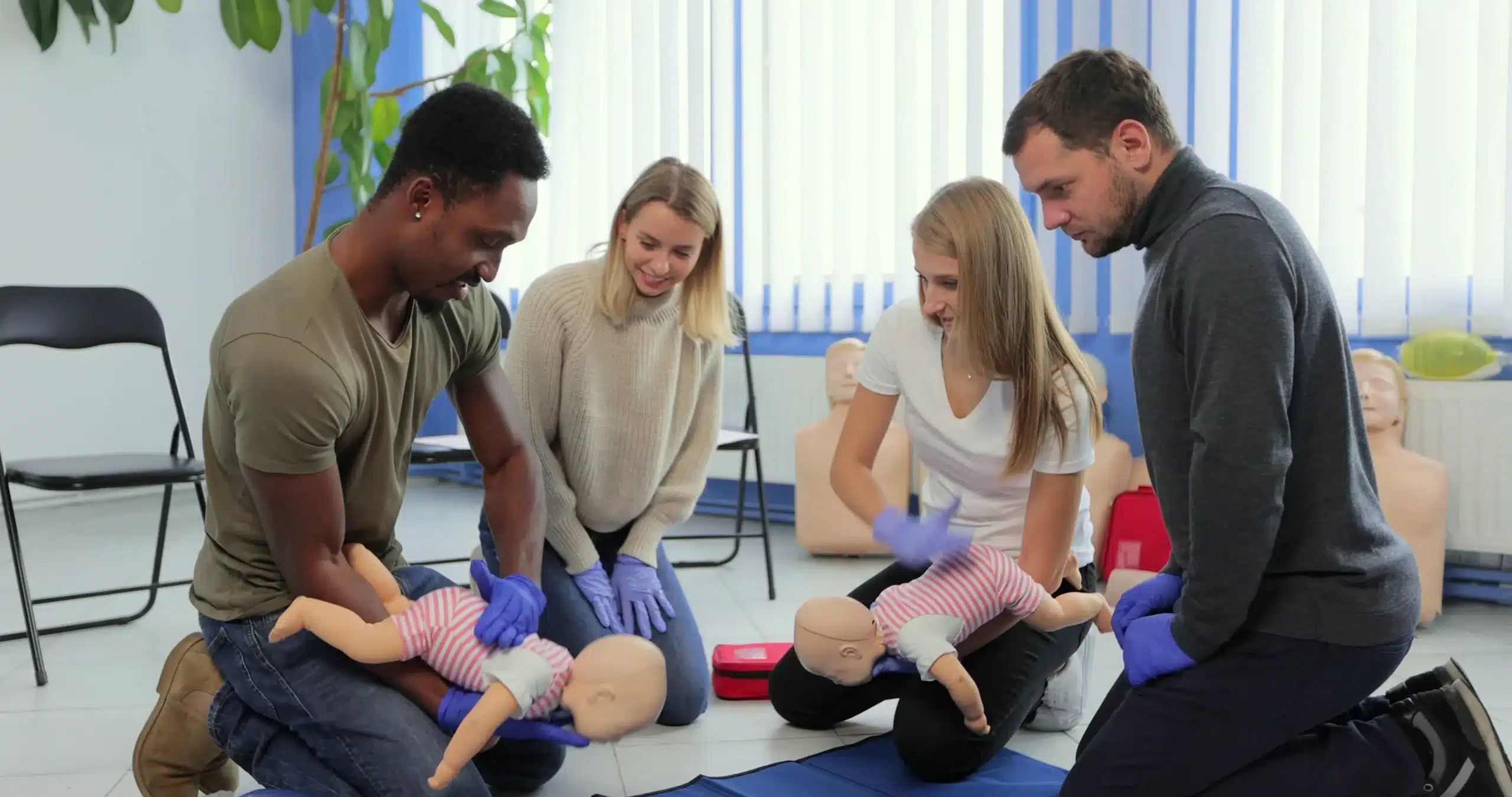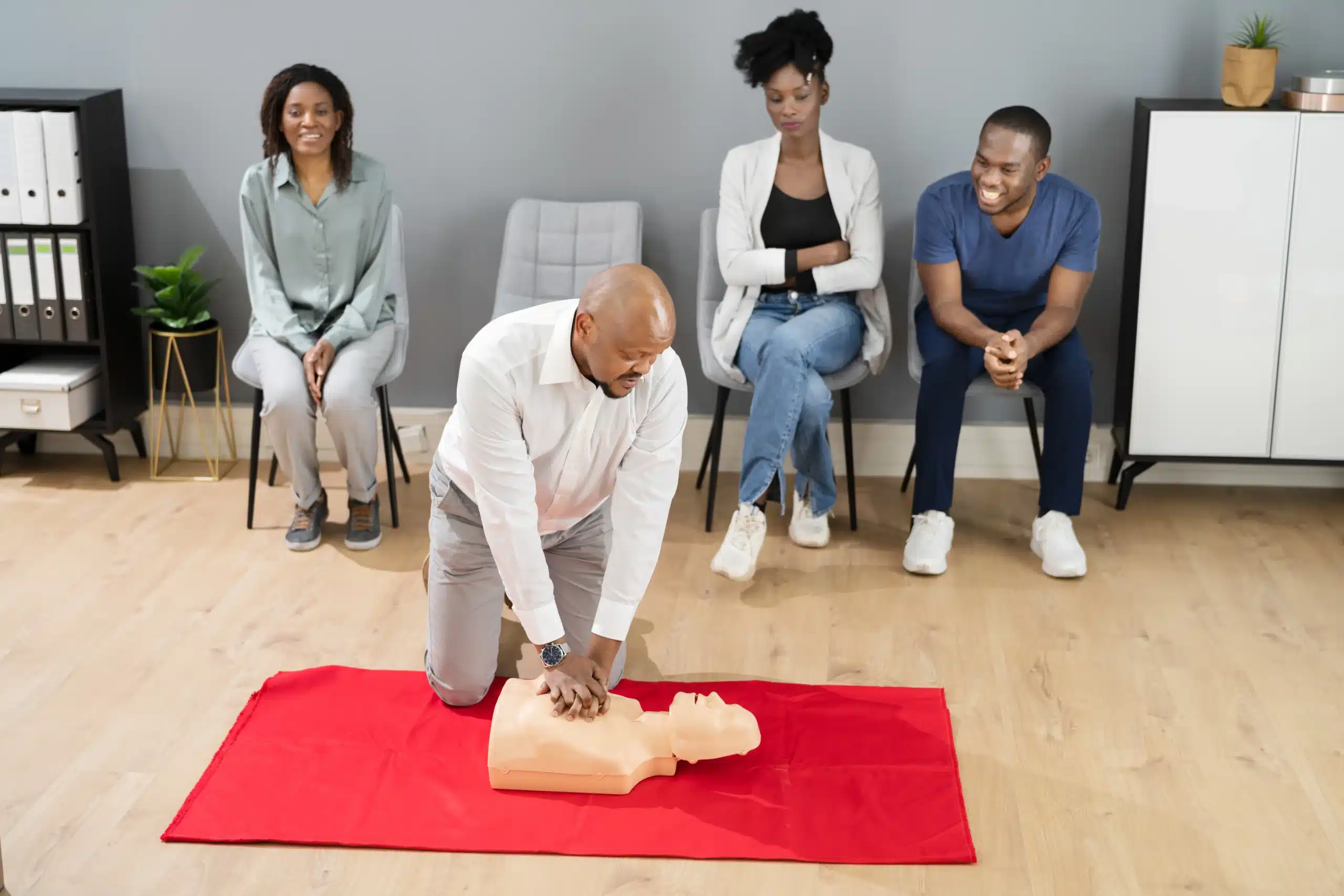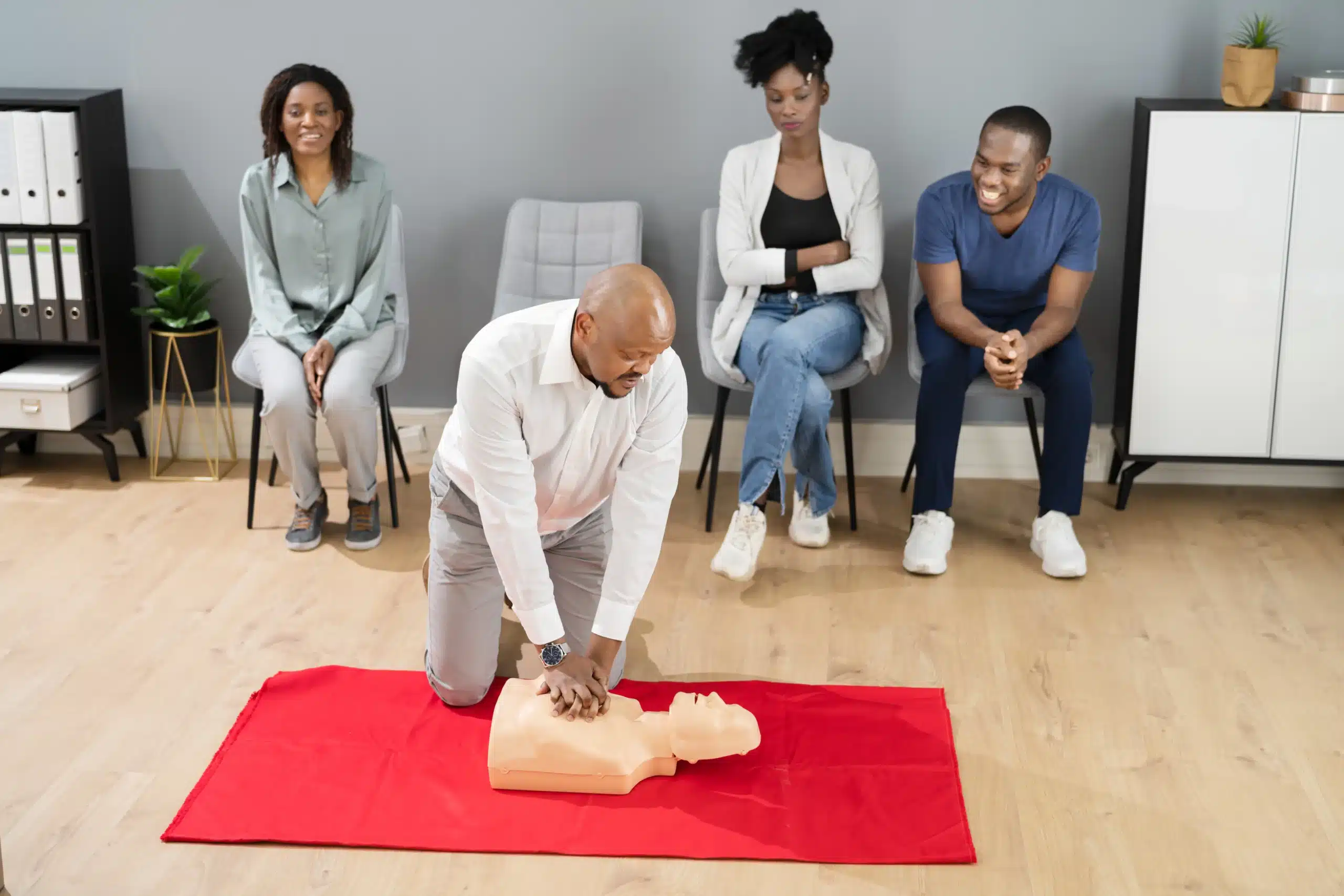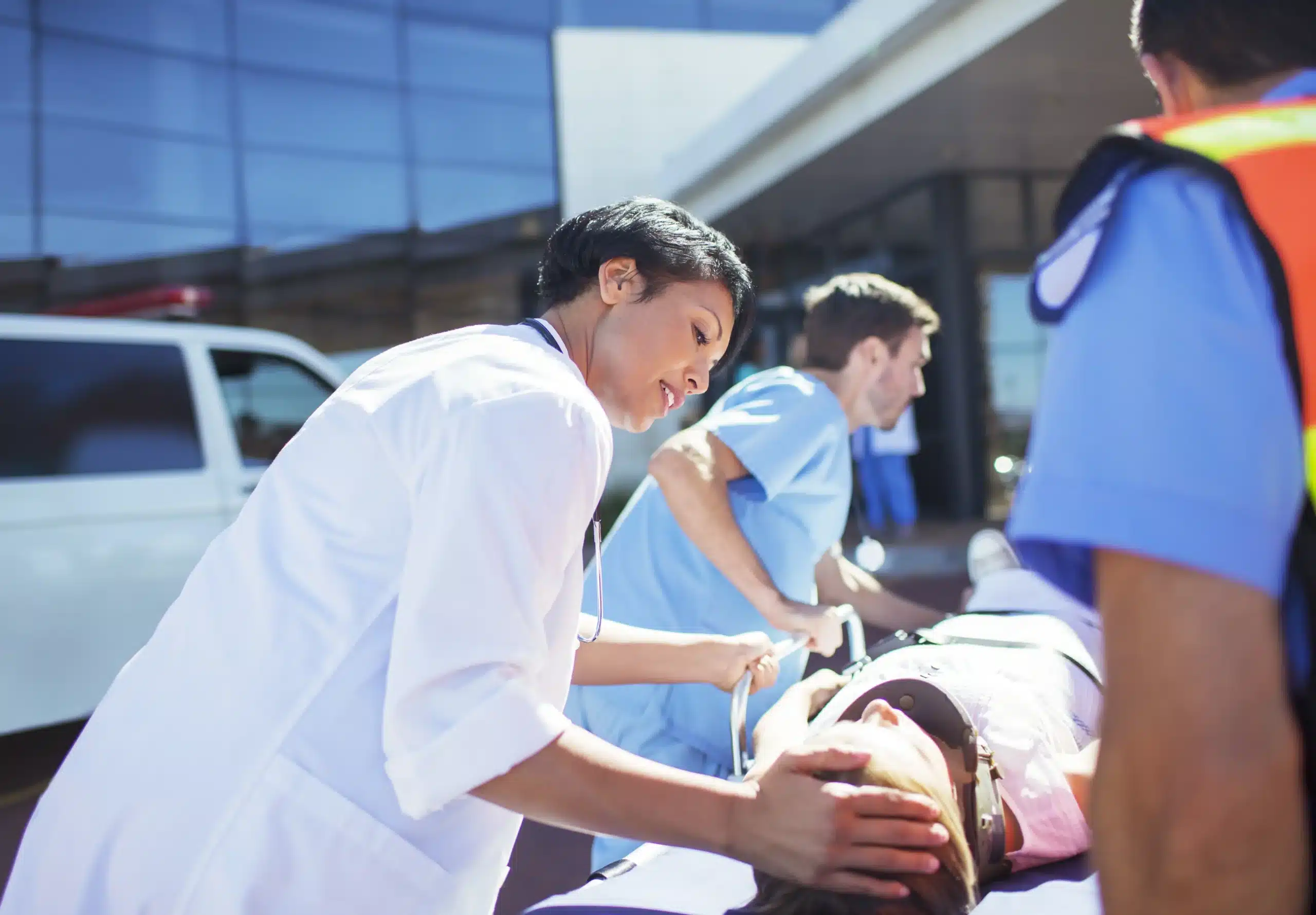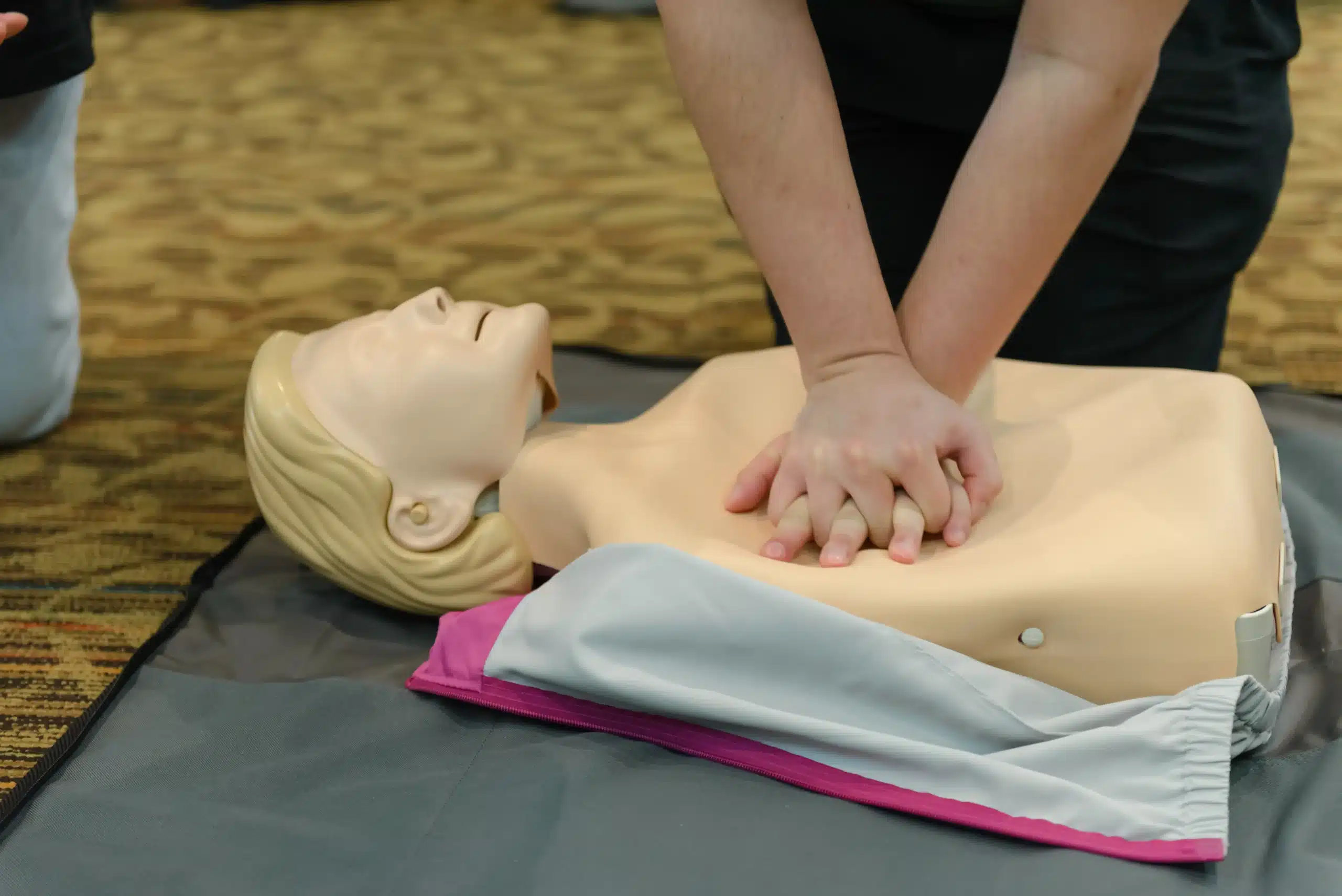Emergencies can happen anytime, anywhere. Knowing CPR can give you the confidence to act quickly and potentially save a life. This guide will cover the basics of CPR, including the different types of courses available and how to find ‘CPR courses near me.’ We’ll also discuss the importance of CPR certification, what to expect during a CPR class, and how CPR training positively impacts community safety. Whether you’re a healthcare worker, a parent, or simply a concerned citizen, this guide will provide you with the knowledge and resources you need to get CPR certified.
Key Takeaways
- CPR skills are essential for everyone: Learning CPR equips you to respond effectively to medical emergencies, regardless of your background. Explore the different CPR course types to find the best fit for your needs.
- Bay Area CPR offers comprehensive training options: From basic to advanced certifications, Bay Area CPR provides a range of courses, including BLS, ACLS, PALS, and Wilderness First Aid, to meet diverse requirements. Check out their flexible scheduling and convenient locations.
- Preparation enhances the learning process: Set yourself up for success by reviewing pre-course materials, dressing comfortably, and bringing a notepad to your CPR class. These small steps can significantly improve your learning experience.
What is CPR and Why is it Important?
CPR, or cardiopulmonary resuscitation, combines chest compressions and rescue breaths to help someone who is unconscious and not breathing. It’s a first-aid technique that can maintain blood flow and oxygen levels until professional medical help arrives. The first and most crucial step in any emergency is always to call 911. CPR buys you precious time while waiting for paramedics.
Over 500,000 cardiac arrests occur annually in the United States, highlighting the critical need for widespread CPR training. Learning CPR empowers you to make a real difference in a life-or-death situation. Even if your CPR certification has expired, remember that attempting CPR is always better than doing nothing. It can significantly improve the chances of survival. CPR is a skill accessible to everyone, not just medical professionals.
Numerous stories and testimonials demonstrate how CPR training has equipped everyday people to save lives. While training provides you with the techniques, understanding how to apply those skills effectively in diverse real-world scenarios is key. This includes adapting to different situations and remaining calm under pressure.
CPR Course Types
Knowing which CPR course is right for you depends on your individual needs and goals. Here’s a breakdown of common CPR course types:
Basic Life Support (BLS)
Basic Life Support (BLS) provides the foundational skills needed to respond to life-threatening emergencies. This course covers core techniques like high-quality CPR for adults, children, and infants, along with AED use and relief of choking. BLS certification is often a requirement for healthcare providers and is valuable for anyone who wants to learn these lifesaving skills.
Advanced Cardiac Life Support (ACLS)
Advanced Cardiac Life Support (ACLS) is designed for healthcare professionals who manage cardiopulmonary arrest and other cardiovascular emergencies. Building upon the fundamentals of BLS, ACLS covers advanced airway management, pharmacology, and team dynamics during resuscitation.
Pediatric Advanced Life Support (PALS)
Pediatric Advanced Life Support (PALS) focuses on the specific needs of infants and children facing medical emergencies. This course equips healthcare providers with the knowledge and skills to recognize and treat pediatric respiratory and cardiac arrest, among other emergencies.
Wilderness First Aid
Wilderness First Aid caters to individuals who work or recreate in remote environments. This course teaches participants how to assess and manage injuries in the wilderness, where access to immediate medical care may be limited. It covers topics like wound care, fracture management, and evacuation procedures.
Find Reputable CPR Courses Near You
Finding the right CPR class can feel overwhelming, but it’s easier than you think. Start by researching local CPR course providers. If you’re in the San Francisco Bay Area, you have a wide range of options, from in-person classes to online learning. Consider your schedule and preferred learning style to find the best fit.
Research Local Providers
A quick online search will reveal numerous CPR training providers. Look for providers with established reputations and a history of quality instruction. For those in the Bay Area, consider checking out Bay Area CPR, which offers various courses and flexible scheduling.
Check Accreditation and Certifications
Ensure the provider and its courses are accredited by a recognized organization like the American Heart Association (AHA). AHA-certified courses meet established standards and are widely accepted. Bay Area CPR offers a range of AHA-certified courses, including BLS, ACLS, PALS, and Wilderness First Aid. This ensures your certification will be recognized by employers and other organizations.
Read Reviews and Ratings
Before committing to a course, read reviews from past students. This can give you valuable insights into the quality of instruction, course materials, and overall learning experience. Don’t hesitate to compare costs and scheduling options to find a course that suits your needs and budget.
Top CPR Course Providers
Several reputable organizations offer CPR training. Here are a few well-known providers:
American Red Cross
The American Red Cross is a trusted name in emergency preparedness and offers various CPR and First Aid courses nationwide.
American Heart Association
The American Heart Association provides a comprehensive list of training centers and instructors offering AHA-certified courses. For example, Safety Training Seminars offers high-quality AHA-certified courses.
Bay Area CPR
Bay Area CPR offers various AHA-certified courses throughout the San Francisco Bay Area, with a focus on flexible scheduling and convenient locations.
National Safety Council
The National Safety Council offers a range of safety training courses, including CPR and First Aid, through a network of authorized training centers.
Local Community Colleges
Many community colleges offer affordable CPR and First Aid training, making them a budget-friendly option. Check with your local community college for course availability and schedules.
What to Expect in a CPR Course
So you’ve decided to take a CPR course—fantastic! Knowing what to expect can help you feel prepared and confident on the day of your training. Here’s a breakdown of what a typical CPR class entails:
Course Duration and Format
CPR courses vary in length depending on the type and level of certification. A Basic Life Support (BLS) course through Bay Area CPR typically takes a few hours, while more advanced courses like ACLS or PALS may require a full day. Bay Area CPR is known for its flexible scheduling and convenient locations, making it easier to fit training into your busy schedule.
Training Methods and Materials
Most CPR courses use a combination of instructional methods, including lectures, videos, demonstrations, and hands-on practice. Many programs now offer hybrid courses, blending online learning with in-person skills practice. This allows you to learn the basics at your own pace before attending a hands-on session. You’ll also receive a student manual and other resources to help you study and retain the information.
Hands-On Practice
The most important part of any CPR course is the hands-on practice. You’ll use a CPR training mannequin to learn exactly where and how hard to press for effective chest compressions. You’ll also practice rescue breaths and learn how to use an automated external defibrillator (AED). Don’t hesitate to ask questions and practice until you feel comfortable with the techniques.
Certification Exams
At the end of the course, you’ll typically take a written exam and a skills test to demonstrate your CPR proficiency. Successful completion earns you a two-year certification. Bay Area CPR also provides free refresher materials (interactive quizzes, videos, etc.) to help you maintain your skills between renewals.
CPR Training Costs
CPR training is an investment in lifesaving skills, and understanding the associated costs can help you budget effectively. Several factors influence the overall expense, including the type of course, location, and training provider. Let’s break down the typical costs associated with CPR training.
Average Price Ranges
CPR course costs vary depending on the level of certification you’re pursuing. Basic Life Support (BLS) renewal courses in San Francisco typically range from $50 to $150. More advanced courses like ACLS (Advanced Cardiovascular Life Support) and PALS (Pediatric Advanced Life Support) generally command higher prices due to the specialized nature of the training. For those seeking Wilderness First Aid certification, costs will also vary based on the course length and intensity. It’s always a good idea to check with various providers, including Bay Area CPR, for their specific pricing. CPR classes in the San Francisco Bay Area can range in price, so doing your research is beneficial.
Potential Discounts and Promotions
Many training centers and organizations offer discounts for group registrations, students, or returning customers. Keep an eye out for promotional offers. Some providers also offer discounts for online or blended learning formats, combining online instruction with in-person skills sessions. Bay Area CPR often has promotions, so checking their website or contacting them directly is recommended.
Additional Fees
While the advertised course fee often covers the core instruction and materials, be aware of potential additional fees. These might include certification card fees, online learning platform access, or equipment costs if you choose to purchase your own. Transparency is key, so don’t hesitate to ask your chosen provider about any extra expenses upfront. Understanding the full cost from the outset helps you plan accordingly.
Choose the Right CPR Course
Knowing which CPR class is right for you depends on your background and goals. Let’s break down the best options for different situations, so you can find the perfect fit.
For Healthcare Professionals
Healthcare providers like doctors, nurses, and EMTs need up-to-date training and certifications. Bay Area CPR offers a range of American Heart Association-certified courses, including BLS, ACLS, and PALS. These courses cover essential life-saving techniques and are designed to meet the specific requirements of healthcare professionals. Make sure to check with your employer or licensing board to confirm the required certifications for your role.
For Parents and Caregivers
As a parent, nanny, or anyone caring for children, knowing CPR and basic first aid can make all the difference in an emergency. While a full healthcare provider certification may not be necessary, a basic CPR and first-aid course focused on infants and children is invaluable. These courses empower you to respond confidently to choking hazards, breathing difficulties, and other unexpected situations.
For Workplace Safety
Many workplaces encourage or require employees to have CPR and first-aid training. This is especially important in environments with potential hazards, such as construction sites, factories, or even offices. Bay Area CPR offers flexible options, including in-person and online courses, to help businesses meet their safety training needs. Check with your company’s HR department to understand their specific requirements.
For the General Public
Even if you’re not a healthcare professional or caregiver, learning CPR is a powerful skill to have. It enables you to assist family members, friends, or even strangers in a medical emergency. CPR courses are widely available, with options ranging from in-person classes to convenient online formats. Choose the format that best suits your learning style and schedule. Knowing CPR can give you the confidence to act quickly and potentially save a life.
Online vs. In-Person CPR Training
Deciding between online and in-person CPR training depends on your needs and learning style. Both formats have their own advantages and disadvantages. Let’s break them down to help you make the best choice.
Pros and Cons of Each Format
Online CPR training offers incredible convenience. You can learn at your own pace, anytime, anywhere, fitting the training around your schedule. Several reputable organizations, including those accredited by the American Heart Association (AHA) and the American Red Cross (ARC), offer valid online CPR certifications. However, online courses typically don’t include the hands-on skills assessment required for some workplaces. While convenient, they may not fully equip you with the practical skills needed for real-life emergencies.
In-person CPR training provides a more interactive and immersive learning experience. You’ll receive direct guidance from certified instructors, benefit from hands-on practice, and have the opportunity to ask questions and receive immediate feedback. In-person training typically results in a two-year certification that meets Occupational Safety and Health Administration (OSHA) requirements. This format is ideal for those who learn best through hands-on practice and value direct interaction with an instructor. However, in-person classes require a greater time commitment and may not offer the same flexibility as online courses. For more information, check out our complete guide to CPR Certification in San Francisco.
Blended Learning
For those seeking a balance between convenience and hands-on practice, blended learning offers a compelling solution. Many CPR training programs now offer hybrid courses that combine online learning with in-person skills sessions. This approach allows you to learn the theoretical aspects of CPR online at your own pace, then attend an in-person session to practice your skills and receive feedback from an instructor. Blended learning offers a flexible and comprehensive approach, ensuring you gain both the knowledge and practical skills necessary to respond effectively in an emergency. It’s a great option for those who want the best of both worlds. Bay Area CPR offers a variety of courses and formats to fit your learning style and schedule.
Get CPR Certified
Getting CPR certified is straightforward. You’ll need to successfully complete a CPR course that meets American Heart Association (AHA) standards. Many providers offer these courses, including Bay Area CPR, which has a range of AHA-certified courses like Basic Life Support (BLS), Advanced Cardiovascular Life Support (ACLS), Pediatric Advanced Life Support (PALS), and Wilderness First Aid.
Exam Requirements
Most CPR courses include a written exam and a practical skills test. The written exam assesses your understanding of CPR principles and techniques. The practical test evaluates your ability to perform CPR on a manikin. Many courses offer practice tests and refresher materials, such as videos and quizzes, to help you prepare and maintain your skills.
Certification Validity and Renewal
CPR certifications are typically valid for two years. To stay current with the latest guidelines, you’ll need to take a CPR renewal course. Renewal costs vary but generally range from $50 to $150 in San Francisco. Providers like Bay Area CPR offer various renewal options, including in-person and online courses, to accommodate different schedules and learning preferences. This makes it easier to stay certified and ready to respond to emergencies.
Prepare for Your CPR Course
Getting ready for your CPR class isn’t just about showing up. A little preparation beforehand can make a big difference in how much you learn. Here’s what you should know:
What to Bring
Practical considerations can greatly enhance your learning experience. Comfortable clothing is a must, as CPR courses often involve physical practice and demonstrations. You’ll want to be able to move freely. A notepad and pen are also recommended for jotting down key points or questions during the course. While many courses offer digital materials, having a physical copy of your notes can be helpful for review. Check with your chosen provider, like Bay Area CPR, about any specific requirements for their courses, such as bringing identification.
Pre-Course Study Materials
Many CPR training organizations offer pre-course materials. Take advantage of these resources! Reviewing them before class can give you a foundational understanding of CPR principles and techniques. This can make the in-class instruction more effective, allowing you to focus on mastering the practical skills. Familiarizing yourself with the basics beforehand, such as recognizing different victim conditions and adapting your CPR technique, can significantly improve your preparedness for hands-on practice. You can find more information on CPR techniques and guidelines from sources like CPR Certification Now. This preparation will help you feel more confident and ready to participate actively in the training.
CPR Training’s Impact on Community Safety
CPR training equips individuals with the skills and confidence to respond effectively in medical emergencies. It empowers them to act quickly and decisively, potentially saving lives and minimizing the severity of injuries. Think of it as a ripple effect, starting with the individual and extending outwards to strengthen the entire community. When more people are trained, the community becomes more resilient and better prepared to handle emergencies.
Learning CPR isn’t just about memorizing steps; it’s about developing a deeper understanding of how to assess critical situations and provide immediate assistance. Real-life stories demonstrate how this knowledge translates into action, turning everyday people into heroes during unexpected events. From hikers on a trail to bystanders witnessing a medical crisis, CPR training provides the tools to make a real difference. Understanding real-life scenarios where CPR is needed helps individuals recognize when to apply their skills and adapt to different situations.
This preparedness extends beyond individual actions. A community with a higher percentage of CPR-trained individuals is better equipped to respond to large-scale emergencies or disasters. This collective knowledge creates a safety net, increasing the chances of positive outcomes for everyone. Whether it’s a sudden cardiac arrest, a drowning incident, or a choking emergency, regular CPR training provides the foundation for effective response and emphasizes the importance of adapting techniques based on the victim’s condition. This adaptability is crucial for providing the most effective care possible. Furthermore, advancements in technology, like real-time CPR feedback tools, enhance the quality of CPR performance, further increasing the chances of survival. These tools provide rescuers with immediate feedback on the rate and depth of compressions, ensuring they are delivering the most effective CPR possible. By embracing these advancements and emphasizing adaptable training methods, we can create even stronger, more prepared communities. Effective CPR training bridges the gap between textbook knowledge and real-world application, empowering individuals to confidently respond to emergencies and contribute to a safer community for everyone.
Frequently Asked Questions
What’s the difference between BLS, ACLS, and PALS?
BLS (Basic Life Support) teaches essential CPR techniques for everyone. ACLS (Advanced Cardiac Life Support) builds upon BLS and is designed for healthcare professionals managing complex cardiac emergencies. PALS (Pediatric Advanced Life Support) focuses on the specific needs of infants and children in medical crises. The right course for you depends on your background and goals.
How do I find a reputable CPR class near me?
Start by searching online for local CPR training providers. Look for providers with established reputations, positive reviews, and accreditation from recognized organizations like the American Heart Association. Check if they offer the specific type of course you need (BLS, ACLS, PALS, etc.) and whether their schedules and locations are convenient for you. Don’t hesitate to contact providers directly to ask questions and compare options.
What can I expect during a CPR course?
Expect a combination of instruction and hands-on practice. You’ll learn CPR techniques, how to use an AED, and how to respond to various emergencies. Most courses involve demonstrations, videos, and practice sessions on mannequins. You’ll likely have a written exam and a skills test to earn your certification.
How much does CPR training cost?
Costs vary depending on the course type, location, and provider. Basic CPR courses typically range from $50 to $150, while more advanced certifications like ACLS and PALS are more expensive. Look for potential discounts for groups, students, or online/blended learning formats. Always confirm the total cost with the provider upfront, including any additional fees for certification cards or materials.
How long is a CPR certification valid, and how do I renew it?
Most CPR certifications are valid for two years. To renew, you’ll need to take a refresher course. Many providers offer renewal courses in both in-person and online formats. Check with your certifying organization or training provider for specific renewal requirements and options.
